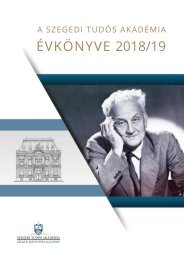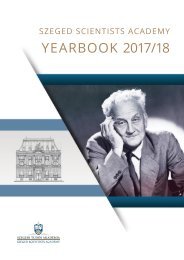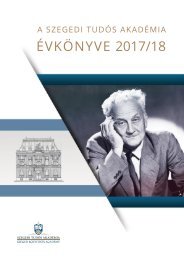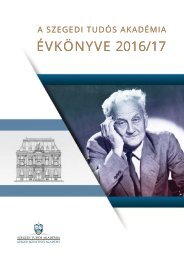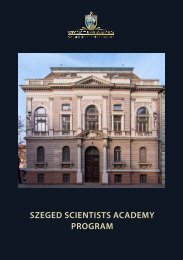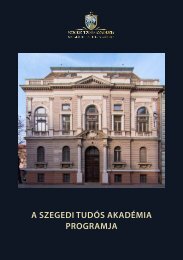SzSA YearBook 2016/17
You also want an ePaper? Increase the reach of your titles
YUMPU automatically turns print PDFs into web optimized ePapers that Google loves.
SZENT-GYÖRGYI MENTORS<br />
ÁGNES VÉGH<br />
Haemodynamic Laboratory,<br />
Department of Pharmacology and Pharmacotherapy,<br />
Faculty of Medicine,<br />
University of Szeged<br />
Address: Dóm tér 12., H-6720 Szeged, Hungary<br />
E: vegh.agnes@med.u-szeged.hu<br />
T: +36 62/545-673<br />
RESEARCH AREA<br />
The problem of sudden cardiac death resulting from ventricular<br />
fibrillation during acute myocardial ischaemia is still<br />
the biggest challenge facing modern cardiology. As drug<br />
therapy has proved to be largely ineffective, understanding<br />
the underlying mechanisms that lead to these life-threatening<br />
ventricular arrhythmias is crucial for developing novel<br />
therapeutic strategies.<br />
Over the last 30 years our research has focused on to explore<br />
possibilities which are able to protect the heart against<br />
these severe often fatal arrhythmias. One of such possibilities<br />
is the phenomenon of preconditioning through<br />
which the heart is able to increase its tolerance against the<br />
consequences of a harmful, by itself fatal ischaemic stress.<br />
Efforts are made on to explore the triggers, the signalling<br />
pathways and end-effectors, which are likely to be involved<br />
in the preconditioning-induced cardioprotection. We attempt<br />
to establish protocols which might be useful in the<br />
therapy for the attenuation of the risk of sudden cardiac<br />
death.<br />
We address various questions using pharmacological<br />
approaches in in vivo animal studies and also in in vitro<br />
examinations by applying various biochemical and molecular<br />
biological methods. Such a comprehensive approach<br />
makes possible to assess processes which act and influence<br />
arrhythmogenesis in the whole body and count for these at<br />
cellular level.<br />
TECHNIQUES AVAILABLE IN THE LAB<br />
In vivo methods: Experiments in large animals – surgical<br />
interventions, measurements of basic haemodynamic,<br />
electrophysiological, blood flow and contractile function<br />
parameters.<br />
In vitro methods: immuno-blotting (e.g. Western blot), RT-<br />
PCR, image analysis (e.g. immunofluorescence confocal<br />
microscopy), immunoprecipitation, ELISA. Through our<br />
collaboration several other methods are available, e.g. SNO-<br />
RAC analysis, RIA.<br />
SELECTED PUBLICATIONS<br />
Gönczi, M., Kovács, M., Seprényi, Gy., Végh, Á. (2012) The<br />
involvement of gap junctions in the delayed phase of the<br />
ptotection induced by cardiac pacing in dogs. Clin Sci 123:<br />
39-51.<br />
Papp, R., Gönczi, M., Kovács, M., Seprényi, Gy., Végh, Á.<br />
(2007) Gap junctional uncoupling plays a trigger role in the<br />
antiarrhythmic effect of ischaemic preconditioning. Cardiovasc<br />
Res 74: 396-405.<br />
Babai, L., Szigeti, Zs., Parratt, J.R., Végh, Á. (2002) Delayed<br />
cardioprotective effects of exercise in dogs are aminoguanidine<br />
sensitive: possible involvement of nitric oxide.<br />
Clin Sci 102: 435-445.<br />
Végh, Á., Szekeres, L., Parratt, J.R. (1992) Preconditioning of<br />
the ischaemic myocardium; involvement of the L-arginine -<br />
nitric oxide pathway. Br J Pharmacology 107: 648-652.<br />
Végh, Á., Komori, S., Szekeres, L., Parratt, J.R. (1992) Antiarrhythmic<br />
effects of preconditioning in anaesthetized<br />
dogs and rats. Cardiovasc Res 26: 487-495.<br />
74







